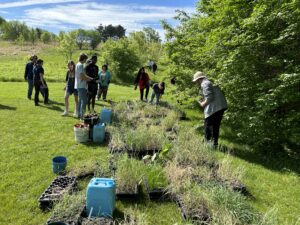Fifty-some years ago it was nothing more than a giant mound of dirt, a lifeless pile of darkness sitting atop a 10-acre patch of oblong land. It existed because of the adjacent hole in the earth, which was as deep as the mound was high.
That hole became Waubonsie Lake. The enormous dirt pile?
My, how you’ve grown, Eola Hill.
Thanks to a prairie restoration initiative championed by science students at Waubonsie Valley High School that began more than 20 years ago, “The Hill” today represents a plush, thriving ecosystem – a high-end habitat for native plants, animals, pollinators, and insects.
Each October, junior- and senior-year students in Carl Armstrong’s botany and AP environmental science classes hand-collect seeds, then wash and freeze them “to simulate overwintering in Illinois,” Armstrong says, and achieve germination beneath LED lighting in Waubonsie’s own greenhouse during the winter spell, before replanting on the Fox Valley Park District’s Eola Hill every spring.
 “Students do considerable work to research and implement protocols to get these seeds to germinate,” Armstrong says.
“Students do considerable work to research and implement protocols to get these seeds to germinate,” Armstrong says.
This year, around 200 students participated in the project, which this week culminated with the planting of more than 5,000 seedlings consisting of six prairie grass species, six forb (or flower) species and a sedge.
“Most of these species are not represented, or only very sparsely represented, in the prairie restoration,” Armstrong says. “These new species will expand the diversity available for pollinators and introduce some earlier-season and subdominant grasses.
“We’ve seen lots more migratory birds now than we did 20 years ago. Monarchs use it as a flyover, and there’s beavers and eagles all over Waubonsie Lake. The project has contributed to an increase in biodiversity in the immediate area.”
Waubonsie student Lucas Mathews can attest. A senior who plans to major in environmental science with an emphasis on forestry at the University of Wisconsin-La Crosse in the fall, Mathews lives nearby, and has kept tabs on the area’s evolution throughout childhood.
“I remember when there was basically nothing on this hill, but the past couple of years we’ve seen the grass rise up a foot, and in a couple years it’ll look even more like a traditional prairie than it does now,” Mathews says. “Some of my seeds froze for four weeks. There was a ton of seeds I was able to collect, so I was pretty confident that at least one would survive the freeze.”
The prairie restoration project was started by a Waubonsie science teacher in 2001 without much fanfare. Armstrong joined the Waubonsie staff in 2006 and assumed the project lead in 2009. The initiative is supported by fellow environmental science teacher Sara Young and her students.
Armstrong collaborated with Helen Wohlfeil, the Fox Valley Park District’s horticulture supervisor whose team provides materials, such as germination trays, soil medium, and “a significant chunk” of forb seed, says Armstrong. “Without that partnership with the park district, this isn’t possible.”
Wohlfeil and members of her team were onsite at Eola Hill this week to celebrate student success and assist where needed. Wohlfeil recalls when certain pockets around the District were simply classified as “no-mow” areas “and we called them prairies,” Wohlfeil says. “As people got more educated and aware, it’s expanded immensely – to the point where horticulture and natural areas is its own department at the Park District.
“I enjoy seeing the kids engaged in something like this. I like the fact that they’re interested in the idea of doing stuff outside and getting their hands dirty when a lot of times everyone just wants to focus on the electronics.”
Despite some obstacles – a leaky greenhouse roof, temperamental heater, and a virus that wiped out a considerable number of milkweed plants – the 2022-23 “Waubonsie Green” crew maintained course and, like the 22 classes before them, left their fingerprints on a long-running restoration initiative that experiences exponential growth each spring.
“We aren’t quite at the ‘professional greenhouse’ level of botanical knowledge, but these teenagers are walking out the door at the end of the year with a considerable skillset of knowledge and experience, and something tangible they can point to in college essays and job interviews,” Armstrong says. “Adding to the prairie restoration is also a nice way to pay it forward to the nearby community and our urban ecosystem.”
